Paul Wilczynski tells how his industrial design background and love of vintage guitars led him to becoming Rickenbacker’s only licensed electric restorer and their only licensed builder of new Ricky acoustics.
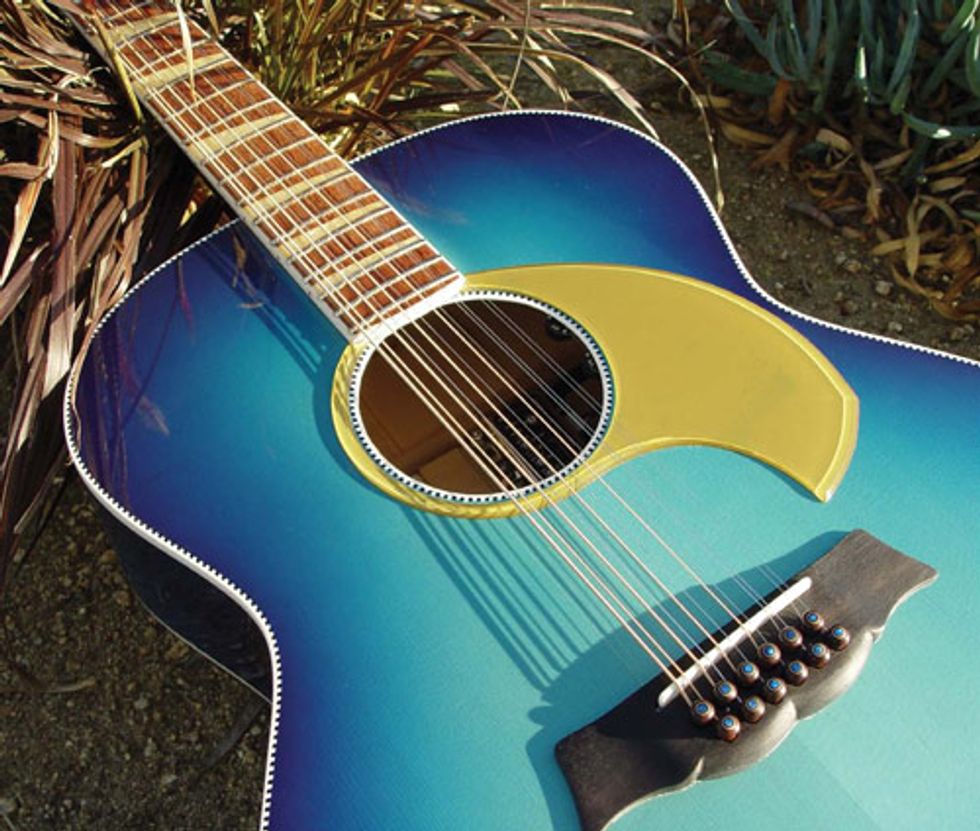
This blueburst/paua 700C/12 offers an up-close look at Paul Wilczynski’s trademark pickguard.
In a world dominated by Gibson- and Fender-style instruments, it is easy to forget that neither Leo Fender nor Orville Gibson created the first commercial electric guitar. Truth be told, the first 6-string instrument manufactured with a pickup was a lap steel invented by George D. Beauchamp with help from Paul Barth and put into production by Adolph Rickenbacker. The 1935 Bakelite Model B Spanish-style guitar made by Rickenbacker predates the Telecaster and the Les Paul by over a decade. This guitar eliminated the acoustic feedback suffered by plugged-in archtops long before the solidbodies of Gibson and Fender.
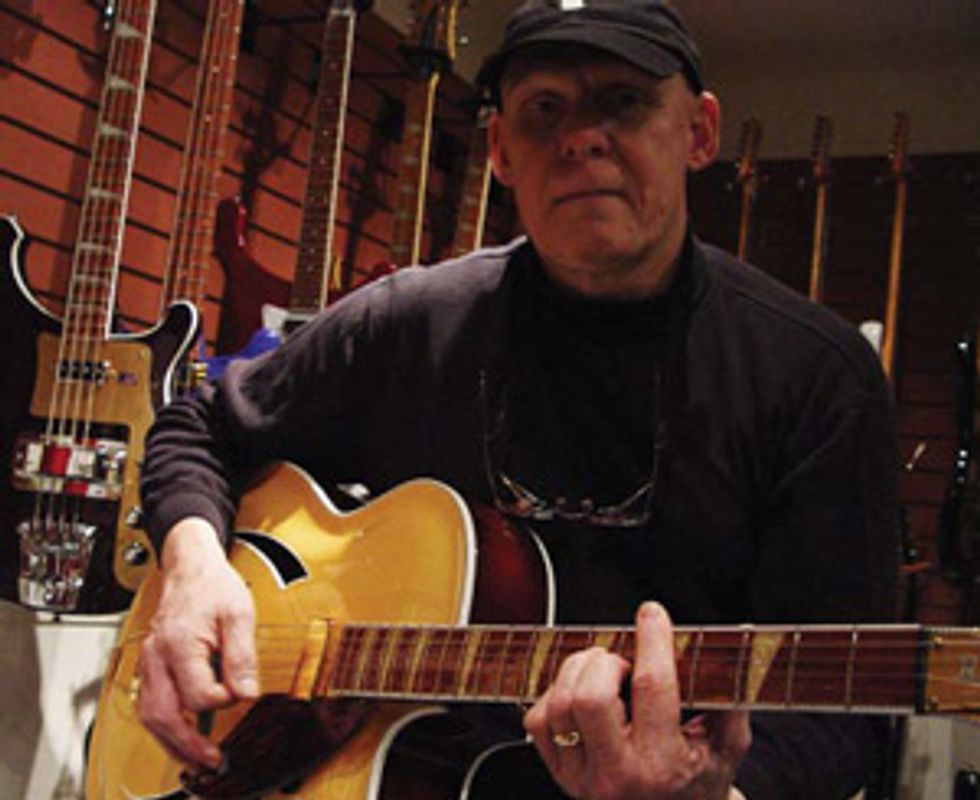 |
So why has Rickenbacker receded into the background in the new Millennium? Who knows—perhaps because jangly pop has fallen from favor? Or, maybe it is the fact that Rickenbackers are all American made. The company doesn’t offer any low-cost, offshore-manufactured models that help spread brand names like Fender and PRS. John Hall and his family still manufacture Rickenbackers in the U.S. of A., just as Adolph Rickenbacker did more than 75 years ago.
When Rickenbacker decided to take a break from making acoustic models in-house, it teamed up with a man as passionate about the Rickenbacker legacy as they are: Paul Wilczynski. A self-described “guitar hobbyist and mediocre musician for about 40 years,” Wilczynski is the man you now call when you want a Rickenbacker flattop—or if you need that vintage Rick restored to its former glory. You can see gorgeous examples of his work at studiocalifornia.rickbeat.com. He has restored, rebuilt, and refinished about 200 Rickenbacker guitars in his one-man shop since May 2005. As Rickenbacker’s sole licensee for construction and restoration, Wilczynski gets all of the company’s non-warranty work. The Bay Area luthier also handbuilds Rickenbacker’s entire line of flattop acoustic instruments— at a rate of one every six to eight weeks.
Wilczynski’s earlier and current alternate lives revolve around industrial design and prototype manufacture— including concept-car design (visit conceptcar.co.uk to see some of the cars Wilczynski has worked on). This craft-oriented background might explain how the first instrument he ever built was good enough to be played by the Jefferson Starship’s Paul Kantner and the Church’s Marty Willson-Piper at Rickenbacker’s 75th Anniversary celebration in August 2006. But let’s let him explain.
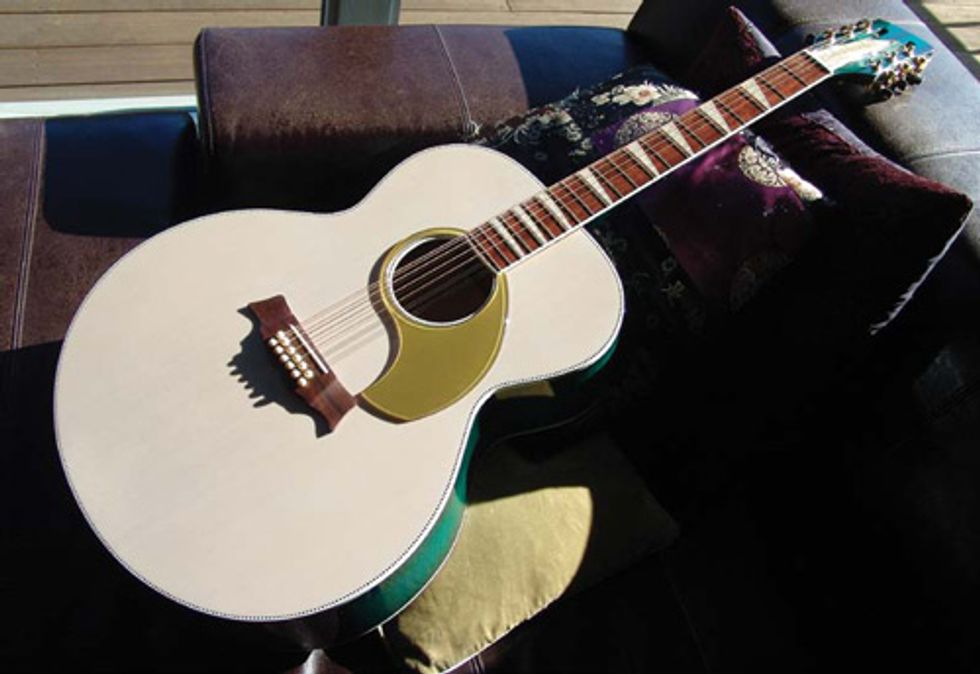
A Rickenbacker 700 Comstock 12-string finished in Mary Kaye white with spruce-green
back and sides. Note typical checkerboard body and soundhole purfling.
How did your debut as a luthier turn out to be such a well-constructed instrument?
Half of it was luck and half of it was knowing what I was doing. I was educated in industrial design at the University of Illinois in Chicago. At that time, I found that I was as interested in actually building things as in designing them. My career ended up being evenly divided between designing objects and building them—not as sculptures, but as working products. After a successful career as a toy designer, I migrated to California and started my own design and fabrication business in Orange County. During that time, I had design firms as customers, and I also worked directly with companies like Xerox, Mazda, GM, and Mitsubishi. I did the design and fabrication work for them in my own shop, or contracted with them to work on their premises. My business was building precision prototypes of anything from stereo systems to automobiles. I started off really knowing my way around a shop: metal shop, wood shop, painting, etc. When I decided to get involved in guitars, I took all these talents and focused them into building instruments. You could say that building guitars is half engineering, half art.
What was your first guitar like?
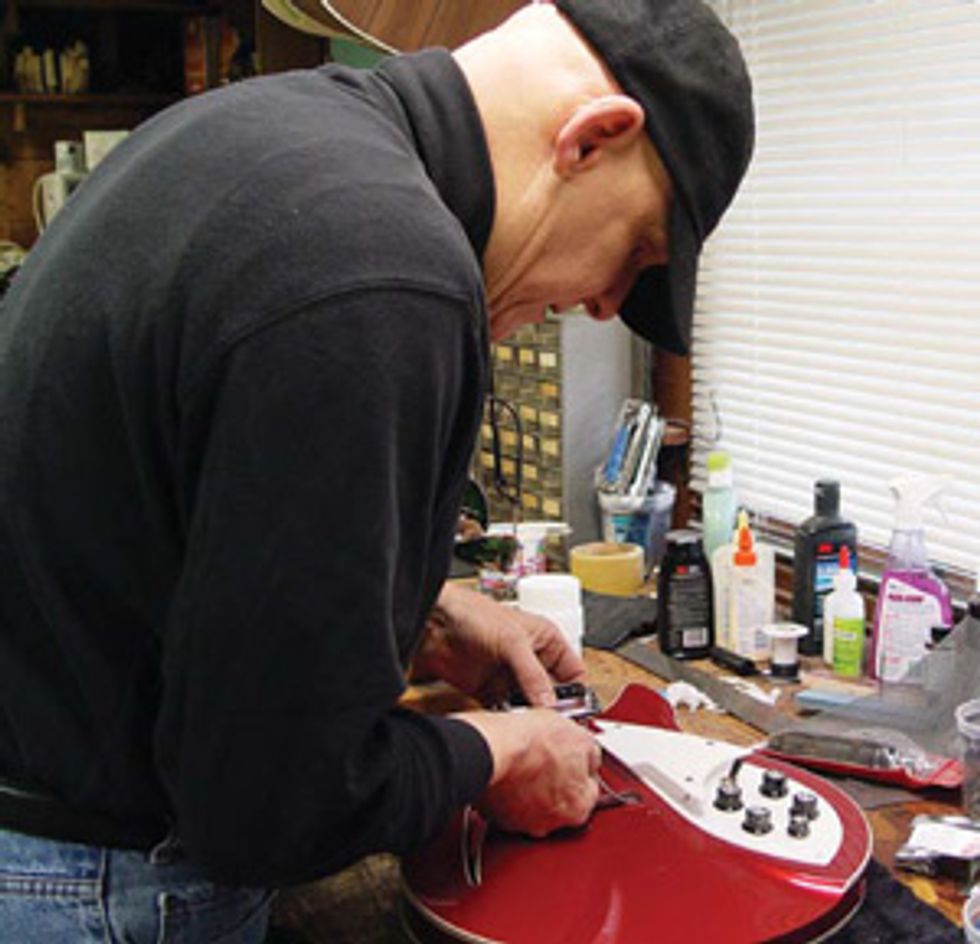 |
How did you originally get into building guitars and end up meeting John Hall?
I was a car collector for years, but in 2004 I decided that I was tired of working on cars. After moving to the Bay Area, I no longer had space for all nine of my cars and ended up selling them. I always loved guitars and music, so instead of cars I decided to get into guitars as a hobby. I sold a Porsche and decided to buy something I had always wanted—a Rickenbacker 12-string.
I was so unfamiliar with the guitar scene at that point that I thought Rickenbacker was out of business until I went on eBay and discovered that new ones were still being made. I called up Wildwood Guitars in Colorado and ordered a brand-new Rickenbacker 660/12 12-string. I was so impressed that the next week I bought a new 381V69. I looked at them and thought, “What would I do to change these?” I started making small changes on them in my shop and posted the changes on the Rickenbacker forums. Within a couple of months, John Hall read the posts and asked me to come visit the shop for a tour.
I took the tour, and then John said he was closing his acoustic shop, at least temporarily. He asked me if I would like the license to build acoustic Rickenbackers for the time being. We made an arrangement. As part of the deal, I picked up all the wood he had left in his acoustic shop and moved it up to the Bay Area. I have been storing it since, and have been using it to build acoustic guitars in my shop under license with the Rickenbacker name and to their specifications.
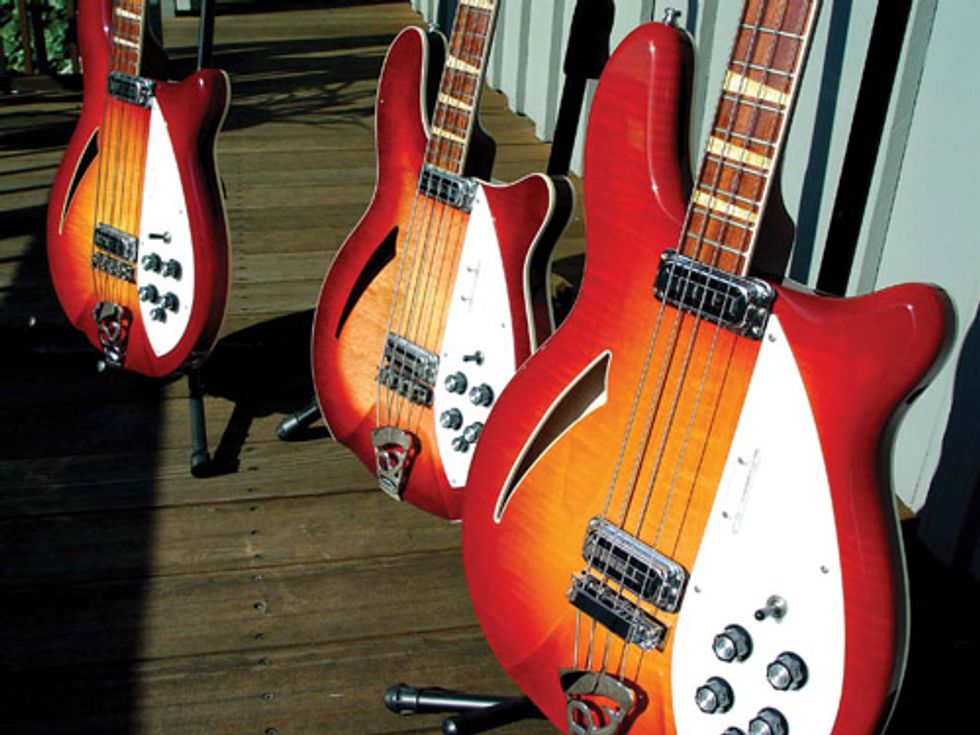
Three ultra-rare, late-’60s Fireglo Rickenbacker 4005 hollowbody basses restored by Wilczynski.
How much work have you done for them since that time?
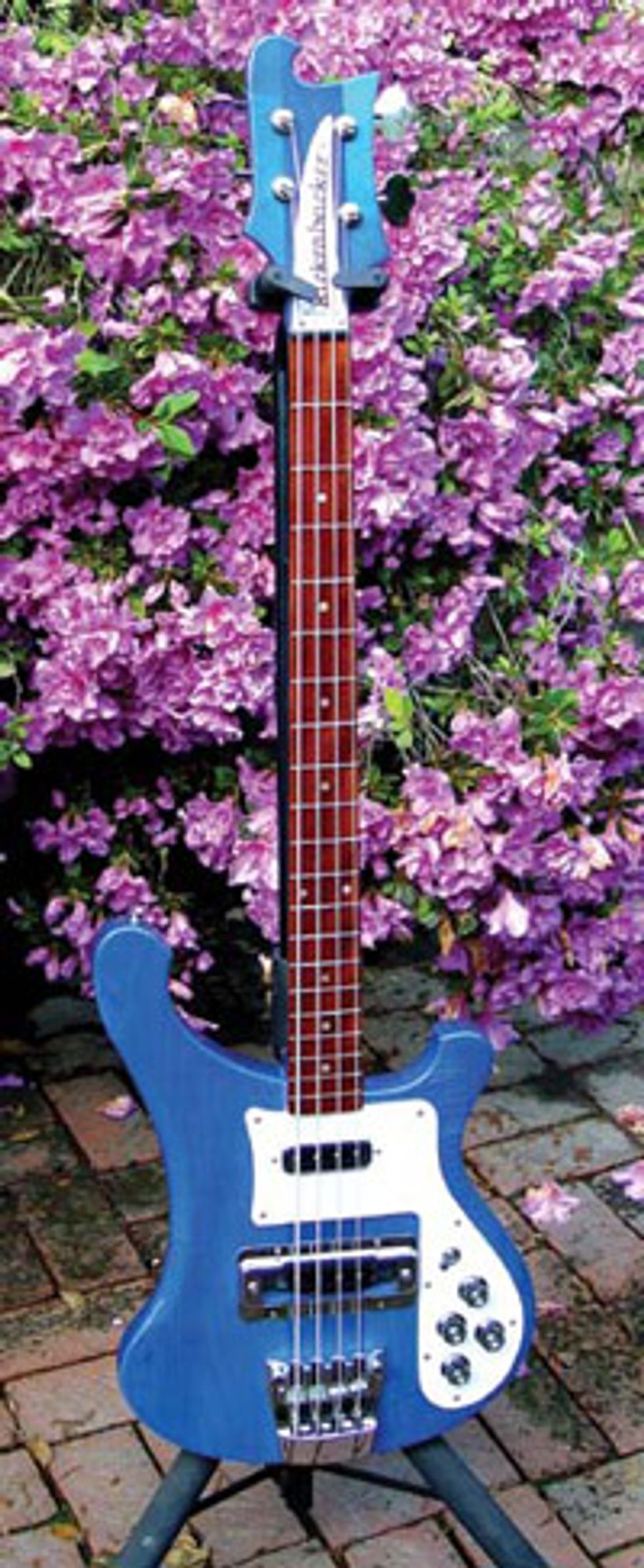 |
Did you reverse-engineer their acoustics—actually pull one apart—to learn how to make them?
Yep. I got a few that were factory seconds and literally cut them in half so I could do the layout for the bracing on the front, figure out how the necks were attached . . . that sort of thing.
What is your attachment to Rickenbackers? Why them as opposed to Fenders or Gibsons?
I don’t know. It’s a real funny thing. When I was playing guitar in high school and college, my dream guitar was a Fender Jaguar [laughs]. I just loved the look of them. I have also loved Rickenbackers since I first played a friend’s McGuinn-style 360/12 in 1965. I was blown away by how easily it played compared to the Fenders and Gibsons I had been playing. The action on it was unbelievable— especially considering it was a 12-string! To me, a 12-guitar had always meant lots of string tension that hurt your fingers. It seemed to me to be the ultimate 12-string guitar, so it was still in the back of my mind when 2004 rolled around and I got back into guitars. When I finally got one, I was impressed by the mystique it had about it and how it felt old and new at the same time. It has a feel that no other guitar has. Since then, I have owned lots of Fenders, lots of Gretsches, and a few Gibsons, and nothing has quite the spirit of a Rickenbacker guitar. It has that historical connection for me.
Do you build Rickenbacker electric guitars?
Nope. I do not have a license to build them, but I do quite a bit of rebuilding and restoration of Rickenbacker electrics. The oldest one I worked on was from 1956. I restore all the models, right up to refinishing new ones in colors that are not available from the factory.
Does Rickenbacker supply you with the hardware and parts for the acoustics?
I purchase them all at dealer prices from Rickenbacker.
So you build the acoustics and sell them?
That is correct—except that I don’t build them first and then sell them. People order them from me. Right now, I am back-ordered about two years. I build each one custom for the individual to his or her style or size. I’ve done a few narrow necks. I did one short-scale. I’ve done some with slanted frets. Just about every one is a special color, as well. Each one is unique, except they all carry the Rickenbacker truss-rod cover and the Rickenbacker body design.
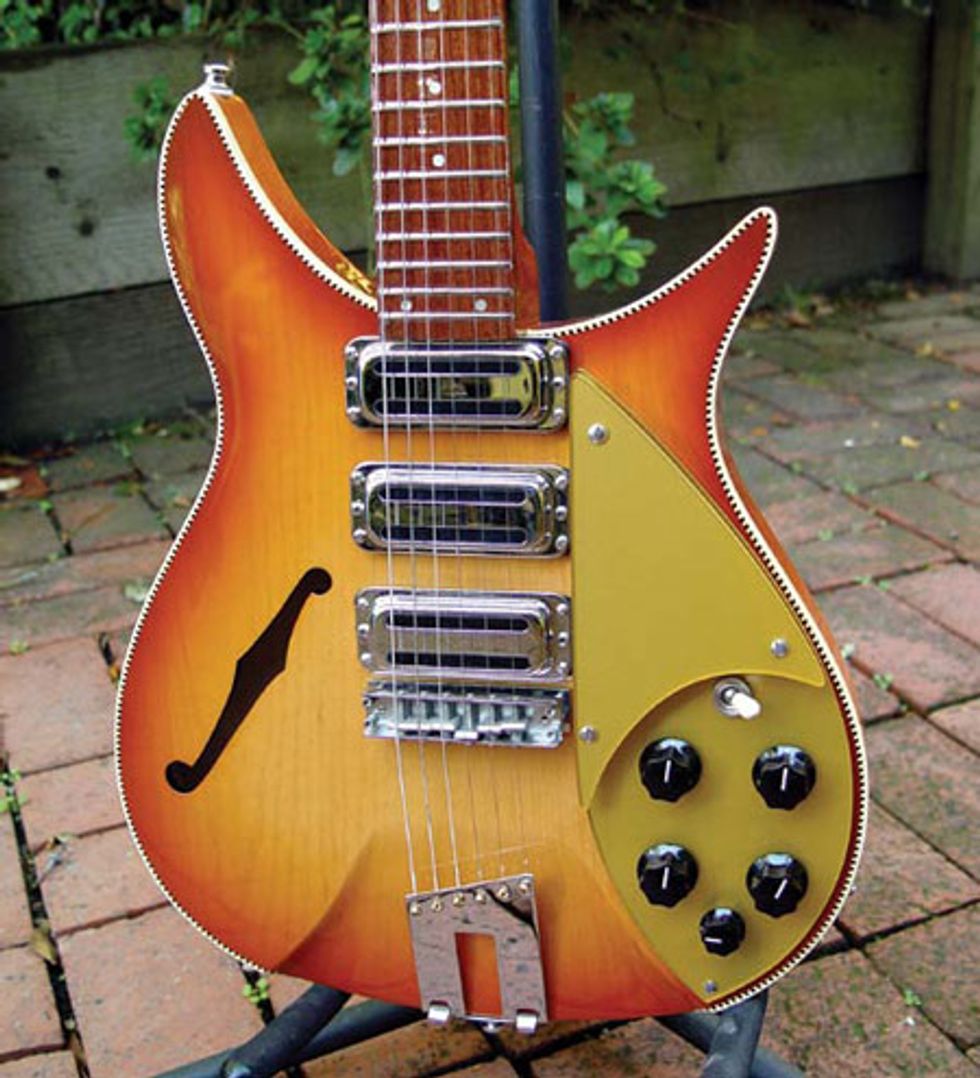
A Honeyglo Rickenbacker 350C63 restored by Wilczynski. Note the added F-hole.
Do you source the wood or get it from Rickenbacker?
Most of the wood came from Rickenbacker’s shop. When I acquired the license, I also acquired a half-container of wood. It was being stored at their shop in Southern California, where it is warm and the humidity is low. I store the container at a vineyard in Sonoma County, where conditions are ideal for storing wood. It is between 55 and 70 degrees year-round and the humidity is about 50 percent. That wood has been acclimated to an ideal situation. I have acoustics that I built three and four years ago that are holding up wonderfully because there is no issue with the wood splitting or shrinking.
Even if someone from, say, New York buys it and puts it through the extremes of that climate?
Yes. Most of my sales are to other areas of the country. I’ve only sold one or two here [in California]. Most of them are going to the East, the South, or to places like Australia, Europe, and Japan.
Are there guidelines from Rickenbacker in terms of building and restoration?
I once had a fellow ask me to restore a Rickenbacker Lightshow [which have flashing lights built-in under a Plexiglas top]—one of the rarest of their guitars. They only built them for a couple of years. If I had to guess, I would say less than a couple of hundred were produced. They are pretty pricey. This guy wanted me to restore his Lightshow, painting it a dark red metalflake with a graphic of a marijuana leaf handpainted on the back [laughs]. I refused to do it. I said it wasn’t a dignified way to treat such a nice old guitar. He got pretty ticked off at me, but in the end I wouldn’t do it.
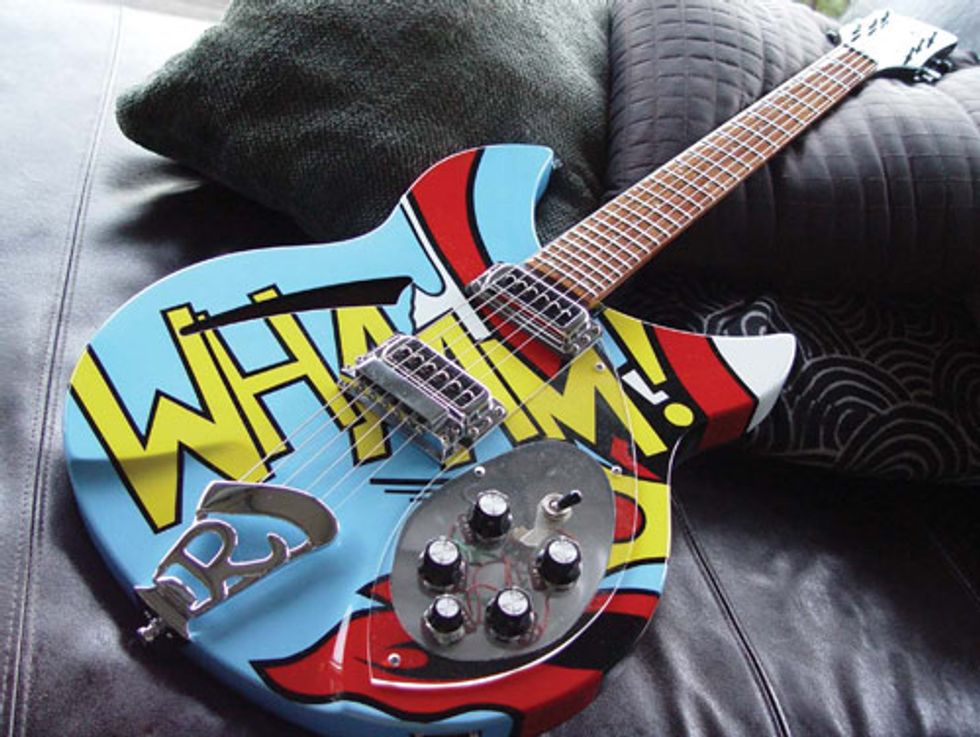
A replica of Paul Weller’s famous “WHAAM!”-graphic Rickenbacker 330 built by Wilczynski.
So, you won’t do major modifications?
People will change the color. I have also converted a couple of 6-strings to 12-strings, and I am busy doing an 8-string bass conversion right now. I don’t mess with their basic formula— it is a Rickenbacker and that is it.
Where is your shop?
I have a shop in Sausalito, where I do my finishing and rough work, like sanding. I also have a shop in my home in Marin County, where I do assembly and setups. I have a third shop up in Sonoma County, near where I store the wood. That’s where I build the acoustic bodies.
Do you still do industrial design for manufacturers?
No. I’m a full-time faculty member and shop manager in the industrial design department at the Academy of Art University. I manage all of their workshops, which means I run the wood, metal, and computer shops. I wrote all the model-making classes for the university— both online and on site. In the evenings and on weekends, I go to my shops and try to catch up on my backlog of restorations and acoustic builds.
Have you thought about starting your own brand?
I’ve done one archtop. John Hall gave me some parts and the permission to build one 760J Jazz-bo, which is Rickenbacker’s carved archtop. They built two or three of them at the factory. It’s a direct copy of one of the designs from the mid-’50s by Roger Rossmeisl. At one time, they were planning on introducing it as part of the acoustic line, and as far as I know they still are. I do not have the license to build Jazzbos, but John gave me one set of Jazz-bo sides and said, “See what you can do with this.” So I built one with a handcarved spruce top, a handcarved maple back, the German carve, and checkerboard binding. I stuck to the original design. I would love to build archtops under my own brand, but I’m a realist and I don’t really think this is something I want to do full-time and struggle to make a living. This part-time thing is working out reasonably well.
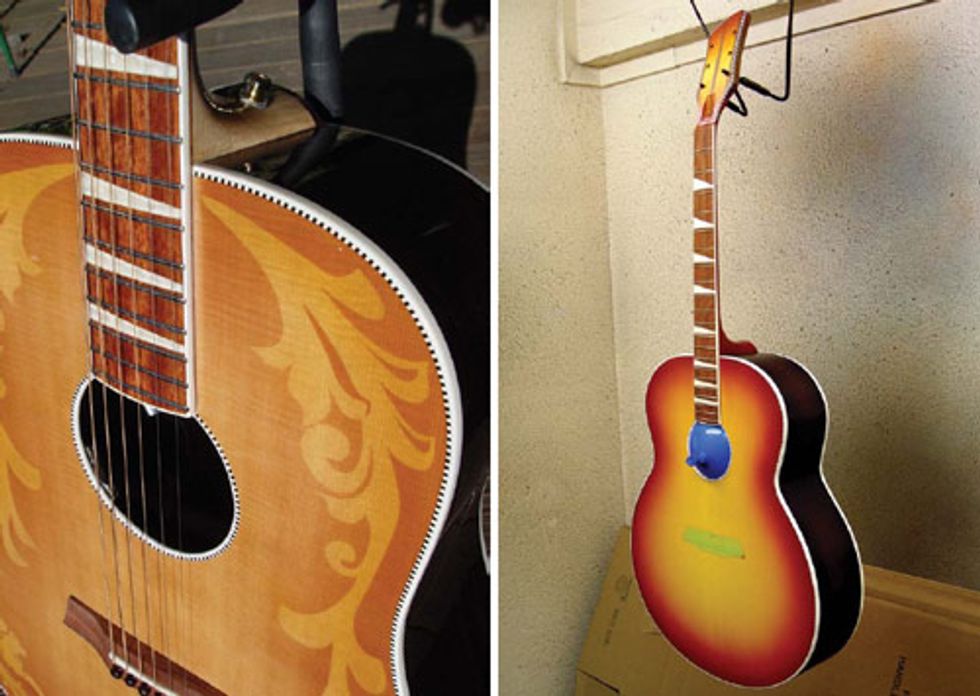
LEFT: A Rickenbacker 730 Shiloh dreadnought with unique Acanthus leaves stenciling by Wilczynski.
RIGHT: A Rickenbacker 700 Shasta about to receive its initial varnish coats.